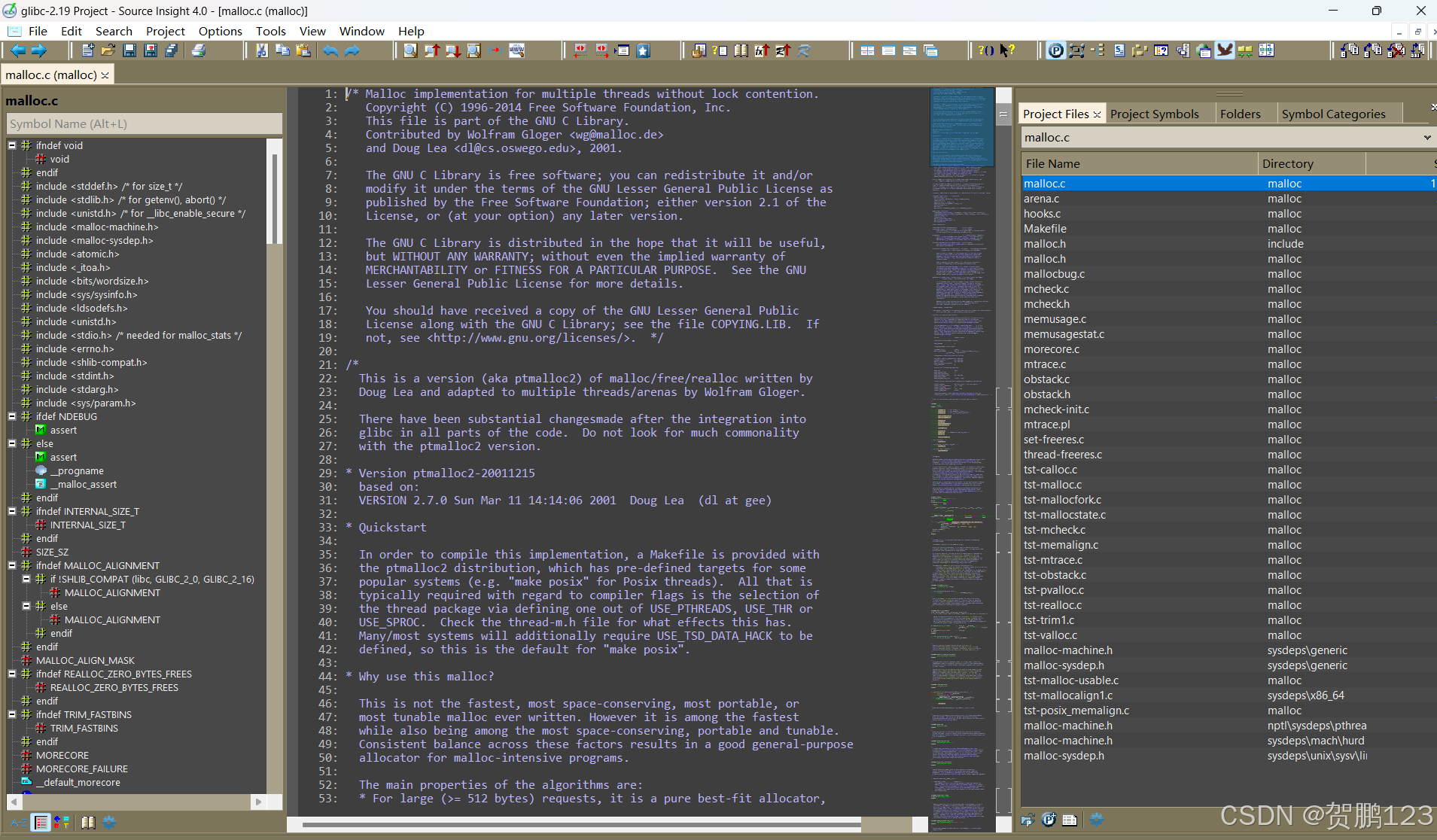malloc内存分配
文章目录
1. 内存分配策略由来
操作数据分配,在堆内存进行分配(因为栈存着私有,数据段存全局,未初始化数据),那既然涉及到分配内存的使用,通过汇编角度的esp指针移动进行内存分配,无外乎就可同理可得,分配内存方式也可以通过指针分配,除了此方式,为了加快速度,也可推理得出可以采用mmap映射
-
brk/sbrk指针:通过在堆内存用指针往高地址移动分配 -
mmap映射:通过在堆里虚拟映射(非主分配区)激活mmap映射的阈值为128byte

2. 代码结果验证
2.1 代码示例
这里我用如下代码进行debug调试,来验证sbrk,mmap
这里分别写了3个malloc的内存分配,为什么数字还不一样,128不是mmap的分配阈值么?怎么还用sbrk指针
先保留点好奇,后面会解答
#include <stdio.h>
#include <stdlib.h>
int main(){
void *p = malloc(0); // sbrk
void *a = malloc(128 * 1024); // sbrk
void *q = malloc(132 * 1024); // mmap
printf("%p\n", p);
printf("%p\n", a);
printf("%p\n", q);
return 1;
}
2.2 验证内存分配2种方式
sbrk指针分配的内存属于层级递增,而mmap属于在堆空间的高地址分配映射。
通过下面代码进行观察输出的地址信息
#include <stdio.h>
#include <stdlib.h>
int main(){
void *p = malloc(0);
void *q = malloc(128 * 1024);
void *y = malloc(132 * 1024);
printf("%p\n", p);
printf("%p\n", q);
printf("%p\n", y);
return 1;
}
=======结果=======
0x1c1c010 // sbrk
0x1c1c030 // sbrk递增分配
0x7f5f4066a010 // mmap映射
3. 源码讲解
3.1 前置预备
由于博主是Java Coder,这里只讲分配内存的直接关联代码,其余业务代码不会进行干涉。
建议小伙伴自行下载sourceinsight新建glibc2.19的源码项目,方便对照eclipsedebug代码进行学习,如果对source insight导入源码,可看博主这篇文章Source Insight 读取源码使用入门
source insight如图

3.2 132kb的sbrk指针开辟的由来
⭐️本源码围绕[2.代码](# 2. 代码示例)进行debug讲解。机器是64位机,size_t对应是64位,8byte
从第一个malloc进行断点,进去malloc方法
这一小节围绕,malloc(0)代码debug

🚀1. 进行入参的大小转化成后续开拓内存的基石
将我们的入参0,转化为内存要求的大小,也就是下面代码checked_request2size(bytes, nb)
这里相关checked_request2size(bytes, nb)的具体实现,我写在了涉及源码调用api部分的下面,之后的代码也是同样如此,形式就如下
主流程源码
== == 涉及源码调用api部分 == ==
调用的api的具体实现
// 将请求大小转换为内部形式加上结构体的大小,获取校准和,以此获取扩展内存的大小的参数之一
// 这里进行nb的赋值,byte为传进来的值,目前第一个malloc传的是0
// 通过下方源码算出来,nb = 32byte
checked_request2size (bytes, nb);
// ===================涉及源码调用api部分=========================
// ===================如何计算的==========================
// checked_request2size源码
#define checked_request2size(req, sz)
// 判断是否超出范围,超出结束进程,并添加错误信息
if (REQUEST_OUT_OF_RANGE (req)) {
__set_errno (ENOMEM);
return 0;
}
// 计算nb
(sz) = request2size (req);
// request2size源码
#define request2size(req)
// (0 + 8 + 15 < 32) ? 32 : ((8 + 15) & ~15) = 16
(((req) + SIZE_SZ + MALLOC_ALIGN_MASK < MINSIZE) ?
MINSIZE :
((req) + SIZE_SZ + MALLOC_ALIGN_MASK) & ~MALLOC_ALIGN_MASK)
// SIZE_SZ源码
#ifndef INTERNAL_SIZE_T
#define INTERNAL_SIZE_T size_t





 最低0.47元/天 解锁文章
最低0.47元/天 解锁文章

















 1314
1314

 被折叠的 条评论
为什么被折叠?
被折叠的 条评论
为什么被折叠?








